Landscape Pattern Consistency Assessment of 10 m Land Cover Products in Different Ecological Zoning Contexts of Sichuan Province, China
Abstract
1. Introduction
2. Study Area and Data
2.1. Study Area
2.2. Study Data
3. Methods
3.1. Consistency of the Spatial Pattern
3.2. Landscape Pattern Analysis
- (1)
- The PD landscape index mainly describes landscape fragmentation and, at the same, time reflects the heterogeneity of the landscape. The calculation formula is:where N is the total patch number and A is the total landscape area.
- (2)
- LSI is used to represent the landscape shape characteristics. The LSI value is closer to 1 when the landscape shape is simpler. The calculation formula is:where E is the total length of all plaques and A is the total area.
- (3)
- AI is mainly used to describe the connectivity between patches. When the AI value is smaller, the patches are more discrete. The calculation formula is:where is the number of analog joins between pixels of patch type .
3.3. Accuracy Verification Based on the Three Independent Samples
4. Results
4.1. Spatial Pattern Consistency under TEOW
4.2. Landscape Pattern Consistency under TEOW
4.3. Absolute Accuracy Evaluation Based on the Three Independent Validation Samples
5. Discussion
5.1. Analysis of the Impact of Land Cover Landscape Patterns on Research under Ecological Zoning
5.2. Discussion of Difference Factors of Multi-Source Remote Sensing Land Cover Data
5.3. Advantages and Disadvantages of Remote Sensing Technology in Land Cover Data Production
6. Conclusions
Author Contributions
Funding
Institutional Review Board Statement
Informed Consent Statement
Data Availability Statement
Conflicts of Interest
References
- Turner, B.; Skole, D.L.; Sanderson, S.; Fischer, G.; Fresco, L.; Leemans, R. Land-use and land-cover change. Science/Research plan. Glob. Change Rep. 1995, 43, 669–679. [Google Scholar]
- Erb, K.H.; Luyssaert, S.; Meyfroidt, P.; Pongratz, J.; Don, A.; Kloster, S.; Kuemmerle, T.; Fetzel, T.; Fuchs, R.; Herold, M. Land management: Data availability and process understanding for global change studies. Glob. Change Biol. 2017, 23, 512–533. [Google Scholar] [CrossRef] [PubMed]
- Franklin, J.; Serra-Diaz, J.M.; Syphard, A.D.; Regan, H.M. Big data for forecasting the impacts of global change on plant communities. Glob. Ecol. Biogeogr. 2017, 26, 6–17. [Google Scholar] [CrossRef]
- Holmberg, M.; Aalto, T.; Akujärvi, A.; Arslan, A.N.; Bergström, I.; Böttcher, K.; Lahtinen, I.; Mäkelä, A.; Markkanen, T.; Minunno, F. Ecosystem services related to carbon cycling–modeling present and future impacts in boreal forests. Front. Plant Sci. 2019, 10, 343. [Google Scholar] [CrossRef] [PubMed]
- Tolessa, T.; Senbeta, F.; Kidane, M. The impact of land use/land cover change on ecosystem services in the central highlands of Ethiopia. Ecosyst. Serv. 2017, 23, 47–54. [Google Scholar] [CrossRef]
- Turner, B.L.; Lambin, E.F.; Reenberg, A. The emergence of land change science for global environmental change and sustainability. Proc. Natl. Acad. Sci. USA 2007, 104, 20666–20671. [Google Scholar] [CrossRef] [PubMed]
- Defourny, P.; Schouten, L.; Bartalev, S.; Bontemps, S.; Cacetta, P.; De Wit, A.; Di Bella, C.; Gérard, B.; Giri, C.; Gond, V. Accuracy assessment of a 300 m global land cover map: The GlobCover experience. New Libr. World 2009, 112, 236–247. [Google Scholar]
- Loveland, T.R.; Reed, B.C.; Brown, J.F.; Ohlen, D.O.; Zhu, Z.; Yang, L.; Merchant, J.W. Development of a global land cover characteristics database and IGBP DISCover from 1 km AVHRR data. Int. J. Remote Sens. 2000, 21, 1303–1330. [Google Scholar] [CrossRef]
- Bartholome, E.; Belward, A.S. GLC2000: A new approach to global land cover mapping from Earth observation data. Int. J. Remote Sens. 2005, 26, 1959–1977. [Google Scholar] [CrossRef]
- Chen, J.; Chen, J.; Liao, A.; Cao, X.; Chen, L.; Chen, X.; He, C.; Han, G.; Peng, S.; Lu, M. Global land cover mapping at 30 m resolution: A POK-based operational approach. ISPRS J. Photogramm. Remote Sens. 2015, 103, 7–27. [Google Scholar] [CrossRef]
- Bonan, G.B.; Oleson, K.W.; Vertenstein, M.; Levis, S.; Zeng, X.; Dai, Y.; Dickinson, R.E.; Yang, Z.-L. The land surface climatology of the Community Land Model coupled to the NCAR Community Climate Model. J. Clim. 2002, 15, 3123–3149. [Google Scholar] [CrossRef]
- Feddema, J.J.; Oleson, K.W.; Bonan, G.B.; Mearns, L.O.; Buja, L.E.; Meehl, G.A.; Washington, W.M. The importance of land-cover change in simulating future climates. Science 2005, 310, 1674–1678. [Google Scholar] [CrossRef] [PubMed]
- Samie, A.; Abbas, A.; Azeem, M.M.; Hamid, S.; Iqbal, M.A.; Hasan, S.S.; Deng, X. Examining the impacts of future land use/land cover changes on climate in Punjab province, Pakistan: Implications for environmental sustainability and economic growth. Environ. Sci. Pollut. Res. 2020, 27, 25415–25433. [Google Scholar] [CrossRef] [PubMed]
- Tharammal, T.; Bala, G.; Narayanappa, D.; Nemani, R. Potential roles of CO2 fertilization, nitrogen deposition, climate change, and land use and land cover change on the global terrestrial carbon uptake in the twenty-first century. Clim. Dyn. 2019, 52, 4393–4406. [Google Scholar] [CrossRef]
- Pérez-Hoyos, A.; García-Haro, F.J.; San-Miguel-Ayanz, J. A methodology to generate a synergetic land-cover map by fusion of different land-cover products. Int. J. Appl. Earth Obs. Geoinf. 2012, 19, 72–87. [Google Scholar] [CrossRef]
- Tsendbazar, N.; De Bruin, S.; Herold, M. Assessing global land cover reference datasets for different user communities. ISPRS J. Photogramm. Remote Sens. 2015, 103, 93–114. [Google Scholar] [CrossRef]
- Pflugmacher, D.; Krankina, O.N.; Cohen, W.B.; Friedl, M.A.; Sulla-Menashe, D.; Kennedy, R.E.; Nelson, P.; Loboda, T.V.; Kuemmerle, T.; Dyukarev, E.; et al. Comparison and assessment of coarse resolution land cover maps for Northern Eurasia. Remote Sens. Environ. 2011, 115, 3539–3553. [Google Scholar] [CrossRef]
- Potapov, P.; Tyukavina, A.; Turubanova, S.; Talero, Y.; Hernandez-Serna, A.; Hansen, M.; Saah, D.; Tenneson, K.; Poortinga, A.; Aekakkararungroj, A. Annual continuous fields of woody vegetation structure in the Lower Mekong region from 2000-2017 Landsat time-series. Remote Sens. Environ. 2019, 232, 111278. [Google Scholar] [CrossRef]
- Zhang, X.; Liu, L.; Chen, X.; Xie, S.; Gao, Y. Fine land-cover mapping in China using Landsat datacube and an operational SPECLib-based approach. Remote Sens. 2019, 11, 1056. [Google Scholar] [CrossRef]
- Kang, J.; Yang, X.; Wang, Z.; Cheng, H.; Wang, J.; Tang, H.; Li, Y.; Bian, Z.; Bai, Z. Comparison of Three Ten Meter Land Cover Products in a Drought Region: A Case Study in Northwestern China. Land 2022, 11, 427. [Google Scholar] [CrossRef]
- Wang, J.; Yang, X.; Wang, Z.; Cheng, H.; Kang, J.; Tang, H.; Li, Y.; Bian, Z.; Bai, Z. Consistency Analysis and Accuracy Assessment of Three Global Ten-Meter Land Cover Products in Rocky Desertification Region—A Case Study of Southwest China. ISPRS Int. J. Geo-Inf. 2022, 11, 202. [Google Scholar] [CrossRef]
- Giri, C.; Zhu, Z.; Reed, B. A comparative analysis of the Global Land Cover 2000 and MODIS land cover data sets. Remote Sens. Environ. 2005, 94, 123–132. [Google Scholar] [CrossRef]
- Yang, Y.; Xiao, P.; Feng, X.; Li, H. Accuracy assessment of seven global land cover datasets over China. ISPRS J. Photogramm. Remote Sens. 2017, 125, 156–173. [Google Scholar] [CrossRef]
- Chen, X.; Lin, Y.; Zhang, M.; Yu, L.; Li, H.; Bai, Y. Assessment of the cropland classifications in four global land cover datasets: A case study of Shaanxi Province, China. J. Integr. Agric. 2017, 16, 298–311. [Google Scholar] [CrossRef]
- Kang, J.; Sui, L.; Yang, X.; Wang, Z.; Huang, C.; Wang, J. Spatial Pattern Consistency among DifferentRemote-Sensing Land Cover Datasets: A Case Studyin Northern Laos. ISPRS Int. J. Geo-Inf. 2019, 8, 201. [Google Scholar] [CrossRef]
- Liang, L.; Liu, Q.; Liu, G.; Li, H.; Huang, C. Accuracy evaluation and consistency analysis of four global land cover products in the Arctic region. Remote Sens. 2019, 11, 1396. [Google Scholar] [CrossRef]
- Hua, T.; Zhao, W.; Liu, Y.; Wang, S.; Yang, S. Spatial consistency assessments for global land-cover datasets: A comparison among GLC2000, CCI LC, MCD12, GLOBCOVER and GLCNMO. Remote Sens. 2018, 10, 1846. [Google Scholar] [CrossRef]
- Liang, D.; Zuo, Y.; Huang, L.; Zhao, J.; Teng, L.; Yang, F. Evaluation of the consistency of MODIS Land Cover Product (MCD12Q1) based on Chinese 30 m GlobeLand30 datasets: A case study in Anhui Province, China. ISPRS Int. J. Geo-Inf. 2015, 4, 2519–2541. [Google Scholar] [CrossRef]
- Bai, Y.; Feng, M.; Jiang, H.; Wang, J.; Zhu, Y.; Liu, Y. Assessing consistency of five global land cover data sets in China. Remote Sens. 2014, 6, 8739–8759. [Google Scholar] [CrossRef]
- Liu, L.; Zhang, X.; Gao, Y.; Chen, X.; Shuai, X.; Mi, J. Finer-resolution mapping of global land cover: Recent developments, consistency analysis, and prospects. J. Remote Sens. 2021, 2021, 5289697. [Google Scholar] [CrossRef]
- Chen, B.; Xu, B.; Zhu, Z.; Yuan, C.; Suen, H.P.; Guo, J.; Xu, N.; Li, W.; Zhao, Y.; Yang, J. Stable classification with limited sample: Transferring a 30-m resolution sample set collected in 2015 to mapping 10-m resolution global land cover in 2017. Sci. Bull 2019, 64, 370–373. [Google Scholar]
- Karra, K.; Kontgis, C.; Statman-Weil, Z.; Mazzariello, J.C.; Mathis, M.; Brumby, S.P. Global land use/land cover with Sentinel 2 and deep learning. In Proceedings of the 2021 IEEE International Geoscience and Remote Sensing Symposium IGARSS, Brussels, Belgium, 11–16 July 2021; pp. 4704–4707. [Google Scholar]
- Zhang, J.; Qian, Z.; Wanggu, X.; Zhang, H.; Wang, Z. Ecosystem pattern variation from 2000 to 2010 in national nature reserves of China. Acta Ecol. Sin 2017, 37, 8067–8076. [Google Scholar]
- Frost, G.V.; Epstein, H.E.; Walker, D.A.; Matyshak, G.; Ermokhina, K. Seasonal and long-term changes to active-layer temperatures after tall shrubland expansion and succession in Arctic tundra. Ecosystems 2018, 21, 507–520. [Google Scholar] [CrossRef]
- Sturm, M.; Schimel, J.; Michaelson, G.; Welker, J.M.; Oberbauer, S.F.; Liston, G.E.; Fahnestock, J.; Romanovsky, V.E. Winter biological processes could help convert arctic tundra to shrubland. Bioscience 2005, 55, 17–26. [Google Scholar] [CrossRef]
- Olson, D.M.; Dinerstein, E.; Wikramanayake, E.D.; Burgess, N.D.; Powell, G.V.; Underwood, E.C.; D’amico, J.A.; Itoua, I.; Strand, H.E.; Morrison, J.C. Terrestrial Ecoregions of the World: A New Map of Life on EarthA new global map of terrestrial ecoregions provides an innovative tool for conserving biodiversity. BioScience 2001, 51, 933–938. [Google Scholar] [CrossRef]
- Sun, B.; Zhou, Q. Expressing the spatio-temporal pattern of farmland change in arid lands using landscape metrics. J. Arid Environ. 2016, 124, 118–127. [Google Scholar] [CrossRef]
- Wang, J.; Wang, Z.; Cheng, H.; Kang, J.; Liu, X. Land Cover Changing Pattern in Pre-and Post-Earthquake Affected Area from Remote Sensing Data: A Case of Lushan County, Sichuan Province. Land 2022, 11, 1205. [Google Scholar] [CrossRef]
- Canters, F. Evaluating the uncertainty of area estimates derived from fuuy land-cover classification. Photogramm. Eng. Remote Sens. 1997, 63, 403–414. [Google Scholar]
- Clark, M.L.; Aide, T.M.; Grau, H.R.; Riner, G. A scalable approach to mapping annual land cover at 250 m using MODIS time series data: A case study in the Dry Chaco ecoregion of South America. Remote Sens. Environ. 2010, 114, 2816–2832. [Google Scholar] [CrossRef]
- Kang, J.; Wang, Z.; Cheng, H.; Wang, J.; Liu, X. Remote Sensing Land Use Evolution in Earthquake-Stricken Regions of Wenchuan County, China. Sustainability 2022, 14, 9721. [Google Scholar] [CrossRef]
- Fung, T.; Ledrew, E.F. The determination of optimal threshold levels for change detection using various accuracy indices. Photogramm. Eng. Remote Sens. 1988, 54, 1449–1454. [Google Scholar]
- Yang, J.; Huang, X. The 30 m annual land cover dataset and its dynamics in China from 1990 to 2019. Earth Syst. Sci. Data 2021, 13, 3907–3925. [Google Scholar] [CrossRef]
- Fritz, S.; See, L.; Perger, C.; Mccallum, I.; Schill, C.; Schepaschenko, D.; Duerauer, M.; Karner, M.; Dresel, C.; Laso-Bayas, J.C. A global dataset of crowdsourced land cover and land use reference data. Sci. Data 2017, 4, 170075. [Google Scholar] [CrossRef]
- Zhao, Y.; Gong, P.; Yu, L.; Hu, L.; Li, X.; Li, C.; Zhang, H.; Zheng, Y.; Wang, J.; Zhao, Y.; et al. Towards a common validation sample set for global land-cover mapping. Int. J. Remote Sens. 2014, 35, 4795–4814. [Google Scholar] [CrossRef]
- Verburg, P.H.; Steeg, J.; Veldkamp, A.; Willemen, L. From land cover change to land function dynamics: A major challenge to improve land characterization. J. Environ. Manag. 2009, 90, 1327–1335. [Google Scholar] [CrossRef]
- Correia Filho, W.L.F.; de Oliveira-Júnior, J.F.; dos Santos, C.T.B.; Batista, B.A.; de Barros Santiago, D.; da Silva Junior, C.A.; Teodoro, P.E.; da Costa, C.E.S.; da Silva, E.B.; Freire, F.M. The influence of urban expansion in the socio-economic, demographic, and environmental indicators in the City of Arapiraca-Alagoas, Brazil. Remote Sens. Appl. Soc. Environ. 2022, 25, 100662. [Google Scholar] [CrossRef]
- Mathias, J.M.; Trugman, A.T. Climate change impacts plant carbon balance, increasing mean future carbon use efficiency but decreasing total forest extent at dry range edges. Ecol. Lett. 2022, 25, 498–508. [Google Scholar] [CrossRef]
- Gao, Y.; Liu, L.; Zhang, X.; Chen, X.; Mi, J.; Xie, S. Consistency analysis and accuracy assessment of three global 30-m land-cover products over the European Union using the LUCAS dataset. Remote Sens. 2020, 12, 3479. [Google Scholar] [CrossRef]
- Kang, J.; Wang, Z.; Sui, L.; Yang, X.; Ma, Y.; Wang, J. Consistency analysis of remote sensing land cover products in the tropical rainforest climate region: A case study of Indonesia. Remote Sens. 2020, 12, 1410. [Google Scholar] [CrossRef]
- Phan, T.N.; Kuch, V.; Lehnert, L.W. Land Cover Classification using Google Earth Engine and Random Forest Classifier—The Role of Image Composition. Remote Sens. 2020, 12, 2411. [Google Scholar] [CrossRef]
- Mahdianpari, M.; Salehi, B.; Rezaee, M.; Mohammadimanesh, F.; Zhang, Y. Very deep convolutional neural networks for complex land cover mapping using multispectral remote sensing imagery. Remote Sens. 2018, 10, 1119. [Google Scholar] [CrossRef]
- Huang, B.; Zhao, B.; Song, Y. Urban land-use mapping using a deep convolutional neural network with high spatial resolution multispectral remote sensing imagery. Remote Sens. Environ. 2018, 214, 73–86. [Google Scholar] [CrossRef]
- Li, X.; Sun, C.; Meng, H.; Ma, X.; Huang, G.; Xu, X. A Novel Efficient Method for Land Cover Classification in Fragmented Agricultural Landscapes Using Sentinel Satellite Imagery. Remote Sens. 2022, 14, 2045. [Google Scholar] [CrossRef]
- Sarif, M.; Gupta, R.D. Spatiotemporal mapping of Land Use/Land Cover dynamics using Remote Sensing and GIS approach: A case study of Prayagraj City, India (1988–2018). Environ. Dev. Sustain. 2022, 24, 888–920. [Google Scholar] [CrossRef]
- Gorelick, N.; Hancher, M.; Dixon, M.; Ilyushchenko, S.; Thau, D.; Moore, R. Google Earth Engine: Planetary-scale geospatial analysis for everyone. Remote Sens. Environ. 2017, 202, 18–27. [Google Scholar] [CrossRef]
- de Sousa, C.; Fatoyinbo, L.; Neigh, C.; Boucka, F.; Angoue, V.; Larsen, T. Cloud-computing and machine learning in support of country-level land cover and ecosystem extent mapping in Liberia and Gabon. PLoS ONE 2020, 15, e0227438. [Google Scholar] [CrossRef] [PubMed]
- Midekisa, A.; Holl, F.; Savory, D.J.; Andrade-Pacheco, R.; Gething, P.W.; Bennett, A.; Sturrock, H.J. Mapping land cover change over continental Africa using Landsat and Google Earth Engine cloud computing. PLoS ONE 2017, 12, e0184926. [Google Scholar] [CrossRef]
- Kang, J.; Yang, X.; Wang, Z.; Huang, C.; Wang, J. Collaborative Extraction of Paddy Planting Areas with Multi-Source Information Based on Google Earth Engine: A Case Study of Cambodia. Remote Sens. 2022, 14, 1823. [Google Scholar] [CrossRef]

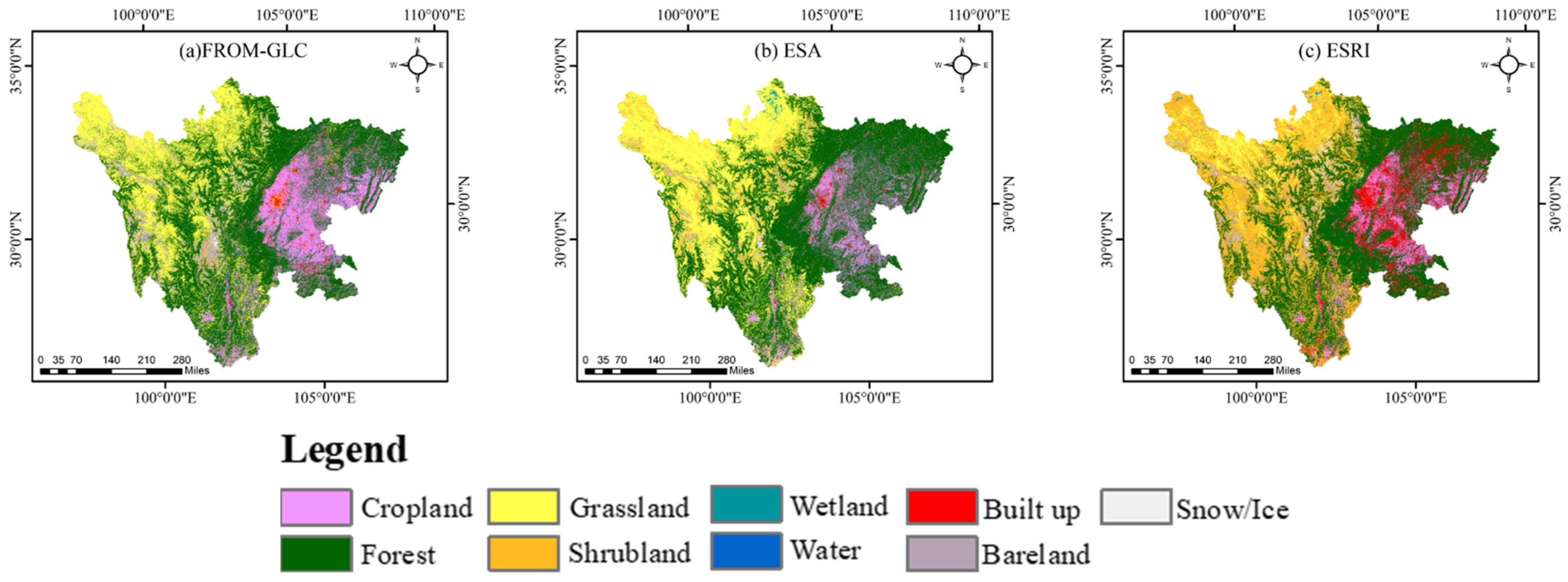


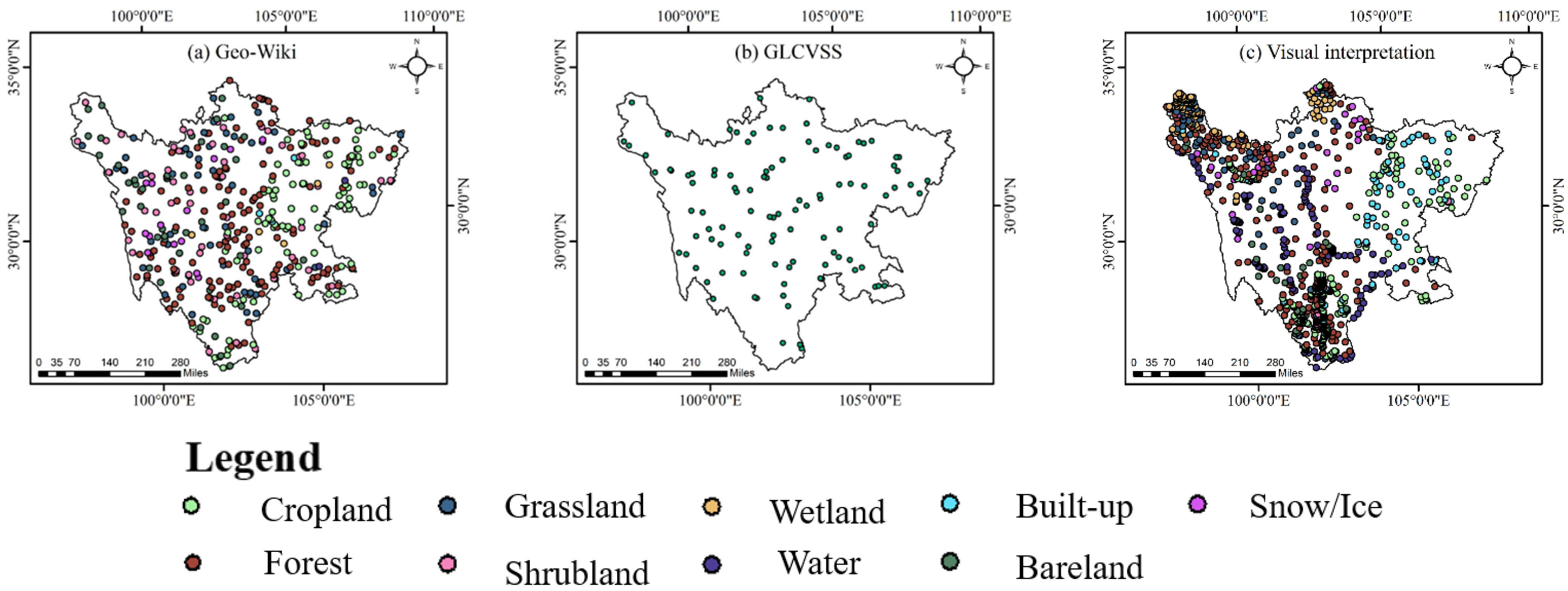
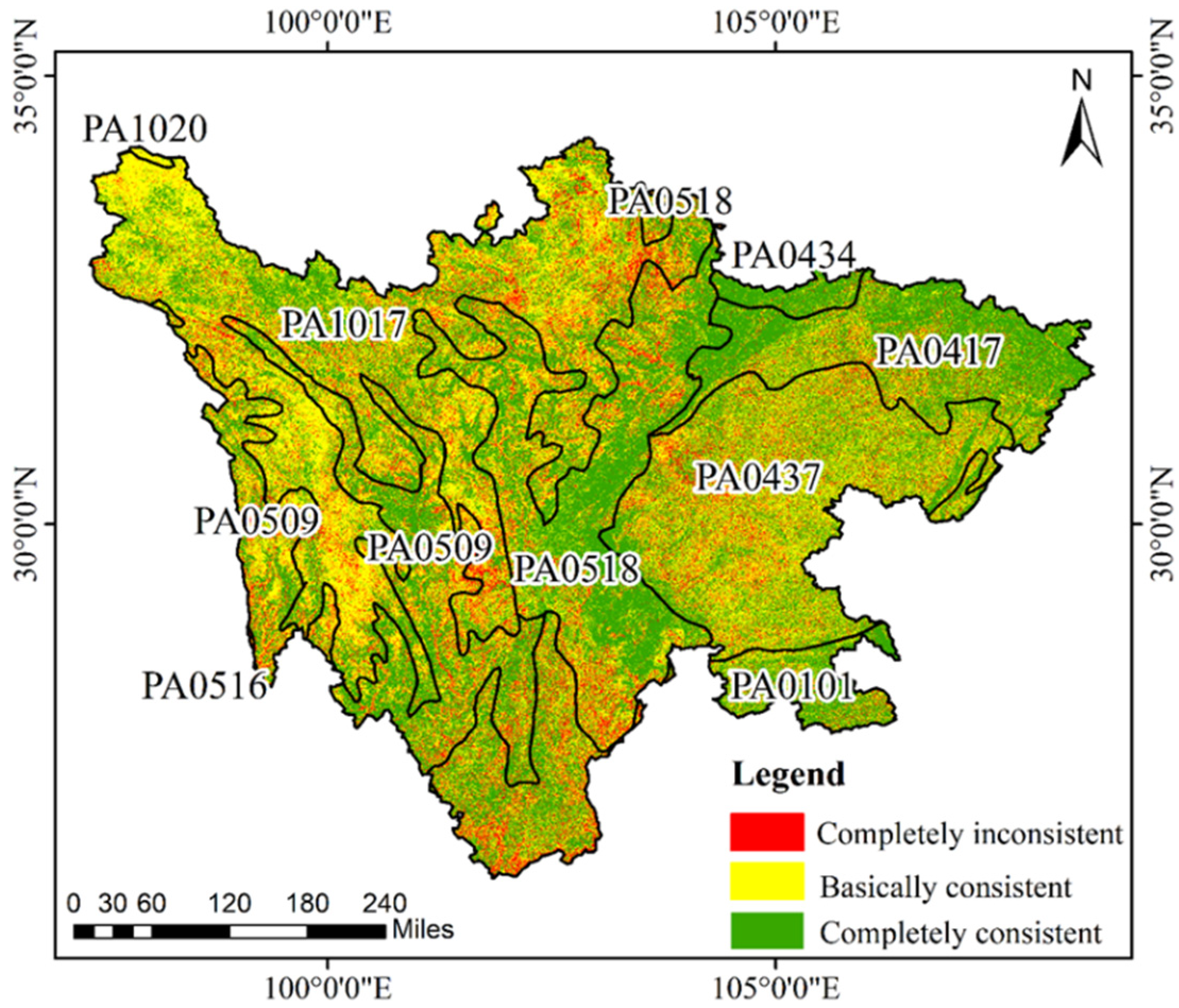
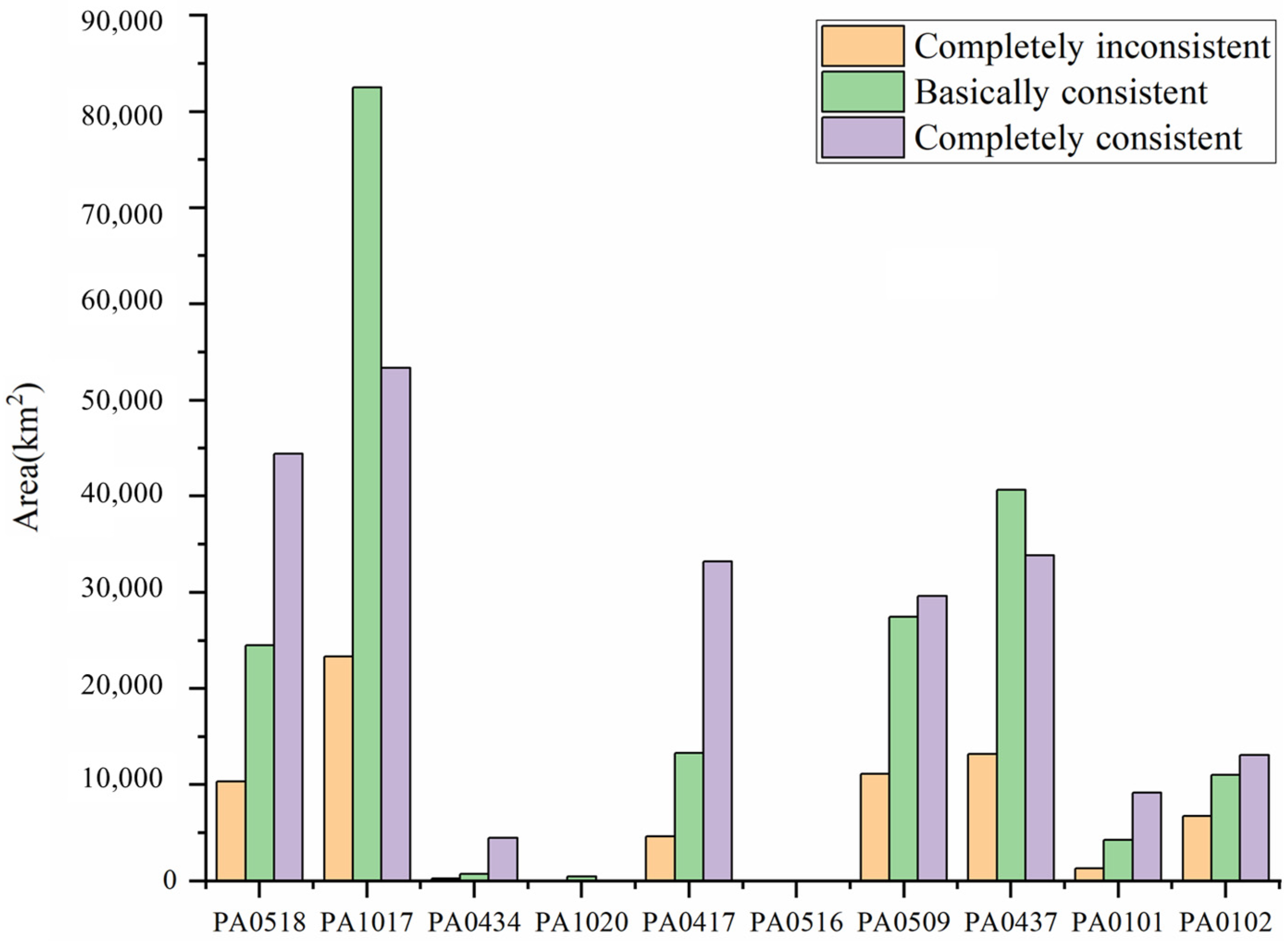

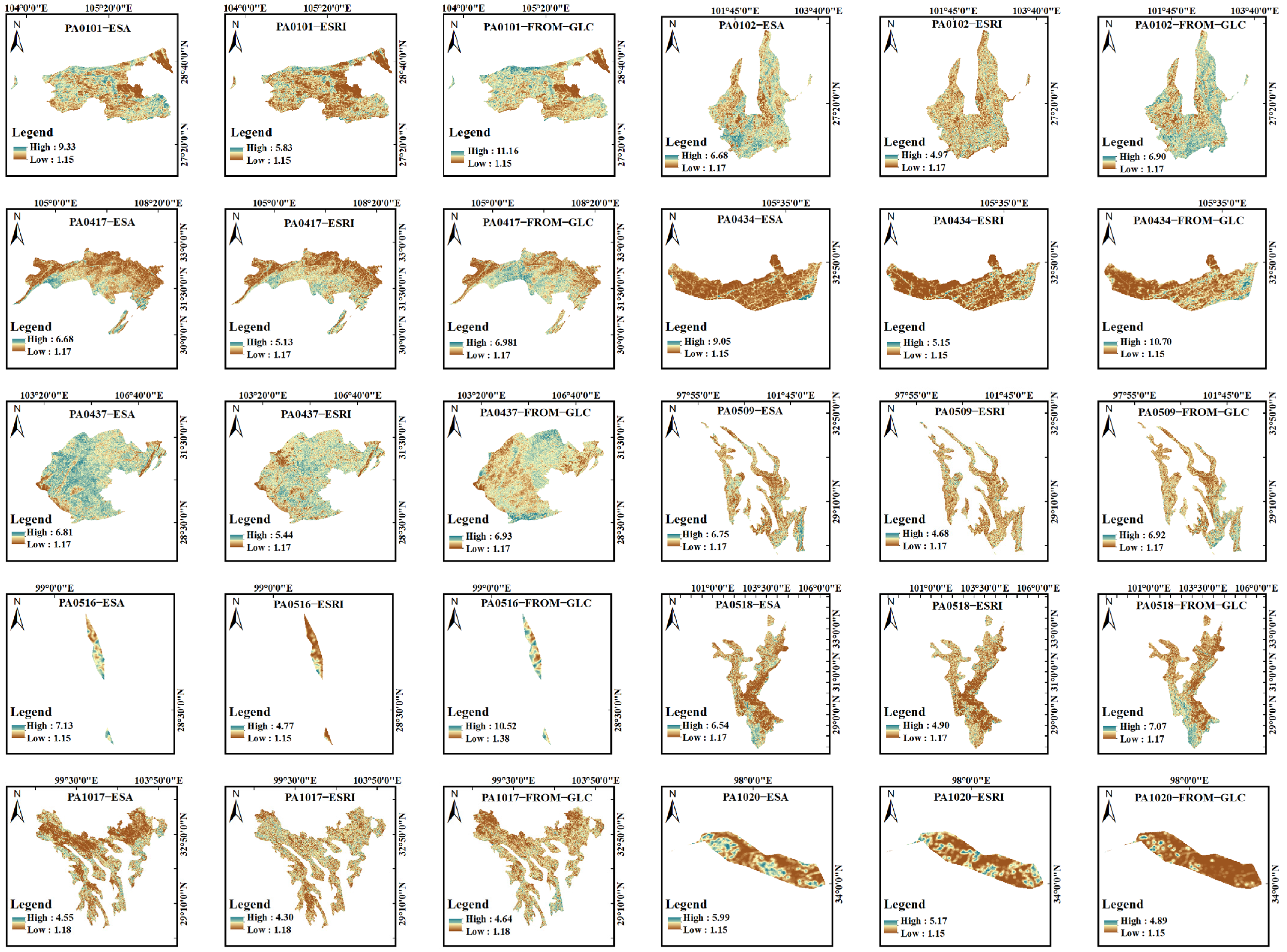

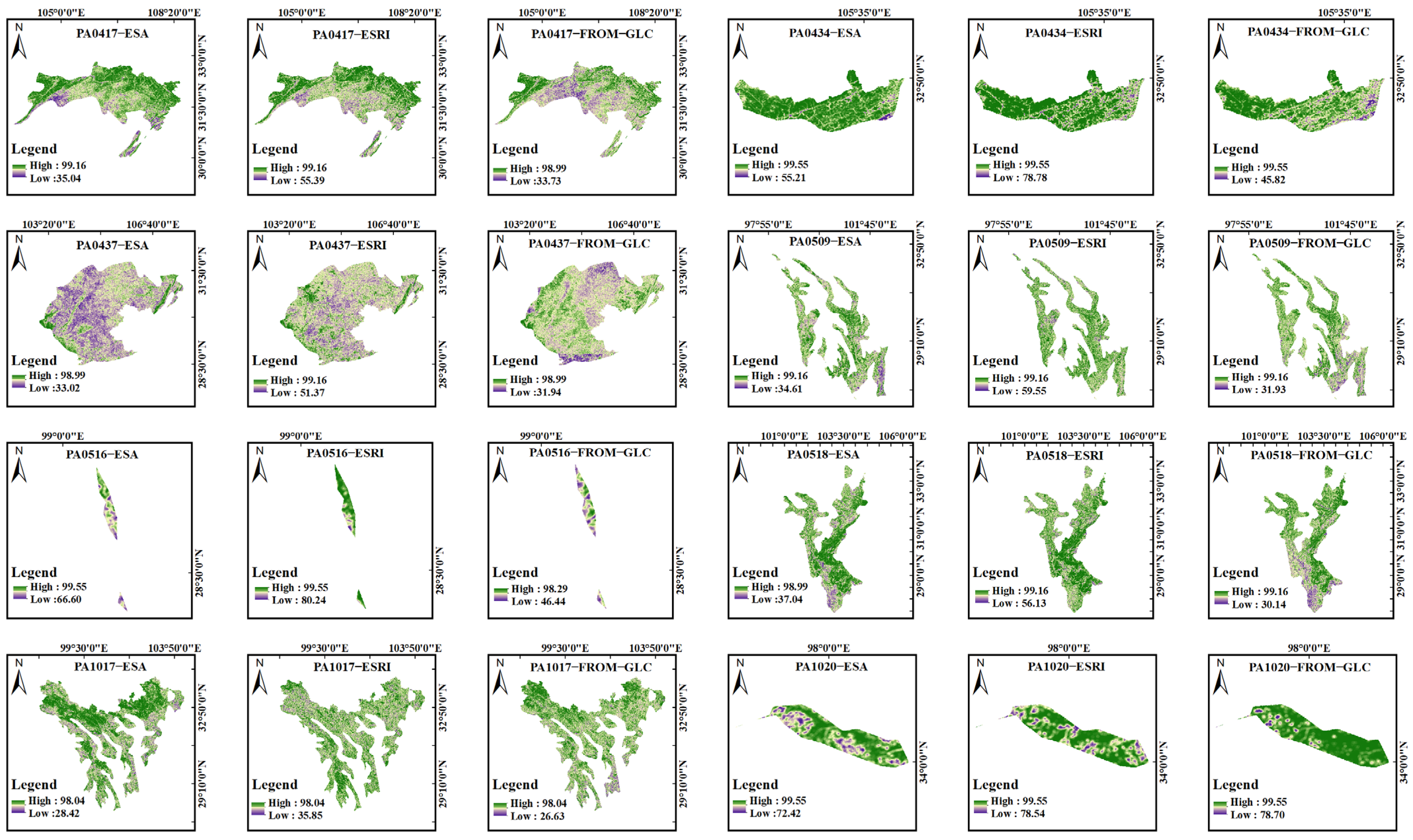


| Name | Resolution(m) | Time | Method | Overall Accuracy (%) | Satellite |
|---|---|---|---|---|---|
| FROM-GLC | 10 | 2017 | Random forest | 72.76 | Sentinel-2 |
| ESA | 10 | 2020 | Deep learning model | 74.40 | Sentinel-1/2 |
| ESRI | 10 | 2020 | Deep learning model | 85.96 | Sentinel-2 |
| Merged | Code | FROM-GLC | Code | ESA | Code | ESRI |
|---|---|---|---|---|---|---|
| Cropland | 10 | Cropland | 40 | Cropland | 5 | Crops |
| Forest | 20 | Forest | 10 | Tree cover | 2 | Trees |
| Grassland | 30 | Grassland | 30 | Grassland | 3 | Grass |
| Shrubland | 40 | Shrubland | 20 | Shrubland | 6 | Shrubs |
| 70 | Tundra | 100 | Moss and lichen | |||
| Wetland | 50 | Wetland | 90 | Herbaceous wetland | 4 | Flooded vegetation |
| 95 | Mangroves | |||||
| Water | 60 | Water | 80 | Permanent water bodies | 1 | Water |
| Built-up | 80 | Impervious surface | 50 | Built-up | 7 | Built area |
| Bare land | 90 | Bare land | 60 | Bare/sparse vegetation | 8 | Bare ground |
| Snow/Ice | 100 | Snow/Ice | 70 | Snow and ice | 9 | Snow/Ice |
| Code | Name |
|---|---|
| PA1017 | Southeast Tibet shrublands and meadows |
| PA1020 | Tibetan Plateau alpine shrublands and meadows |
| PA0509 | Hengduan Mountains subalpine conifer forests |
| PA0516 | Nujiang Langcang Gorge alpine conifer and mixed forests |
| PA0518 | Qionglai-Minshan conifer forests |
| PA0101 | Guizhou Plateau broadleaf and mixed forests |
| PA0102 | Yunnan Plateau subtropical evergreen forests |
| PA0417 | Daba Mountains evergreen forests |
| PA0434 | Qin Ling Mountains deciduous forests |
| PA0437 | Sichuan Basin evergreen broadleaf forests |
| Geo-Wiki | ||||||||||||
|---|---|---|---|---|---|---|---|---|---|---|---|---|
| 1 | 2 | 3 | 4 | 5 | 6 | 7 | 8 | 9 | OA (%) | Kappa | ||
| FROM-GLC | PA (%) | 53.61 | 48.64 | 28.89 | 16.67 | 0.00 | 62.50 | 8.33 | 37.14 | 0.00 | 41.99 | 0.24 |
| UA (%) | 33.99 | 73.36 | 55.32 | 1.43 | 0.00 | 41.67 | 15.39 | 13.13 | 0.00 | |||
| ESA | PA (%) | 67.71 | 40.28 | 25.71 | 25.00 | No data | 55.56 | 33.33 | 20.00 | No data | 37.86 | 0.19 |
| UA (%) | 17.39 | 81.56 | 57.45 | 4.29 | 0.00 | 41.67 | 15.39 | 5.05 | 0.00 | |||
| ESRI | PA (%) | 64.29 | 64.11 | 27.66 | 14.08 | No data | 38.46 | 10.89 | 41.67 | 100 | 39.37 | 0.25 |
| UA (%) | 23.53 | 75.41 | 13.83 | 41.43 | 0.00 | 41.67 | 84.62 | 5.05 | 8.00 | |||
| GLCVSS | ||||||||||||
|---|---|---|---|---|---|---|---|---|---|---|---|---|
| 1 | 2 | 3 | 4 | 5 | 6 | 7 | 8 | 9 | OA (%) | Kappa | ||
| FROM-GLC | PA (%) | 53.85 | 62.75 | 4.00 | No data | No data | 0.00 | 0.00 | 9.09 | No data | 38.68 | 0.18 |
| UA (%) | 35.00 | 78.05 | 11.11 | 0.00 | No data | No data | No data | 4.55 | 0.00 | |||
| ESA | PA (%) | 57.14 | 66.67 | 18.75 | 0.00 | No data | 0.00 | 0.00 | 16.67 | No data | 40.57 | 0.23 |
| UA (%) | 20.00 | 78.05 | 66.67 | 0.00 | No data | No data | No data | 4.55 | 0.00 | |||
| ESRI | PA (%) | 75.00 | 71.74 | 0.00 | 12.12 | No data | 0.00 | 0.00 | 50.00 | 50.00 | 42.45 | 0.27 |
| UA (%) | 30.00 | 80.49 | 0.00 | 66.67 | No data | No data | No data | 4.55 | 12.50 | |||
| Visual Interpretation | ||||||||||||
|---|---|---|---|---|---|---|---|---|---|---|---|---|
| 1 | 2 | 3 | 4 | 5 | 6 | 7 | 8 | 9 | OA (%) | Kappa | ||
| FROM-GLC | PA (%) | 86.28 | 74.57 | 17.97 | 0.00 | 0.00 | 97.65 | 82.83 | 12.07 | 100 | 58.40 | 0.51 |
| UA (%) | 70.40 | 70.49 | 82.81 | 0.00 | 0.00 | 61.94 | 67.21 | 19.44 | 25.93 | |||
| ESA | PA (%) | 88.79 | 73.25 | 20.37 | 0.00 | 91.67 | 100 | 93.33 | 9.33 | 100 | 59.87 | 0.53 |
| UA (%) | 68.59 | 62.84 | 85.94 | 0.00 | 12.09 | 76.87 | 68.85 | 19.44 | 18.52 | |||
| ESRI | PA (%) | 92.81 | 86.26 | 35.71 | 3.01 | 88.89 | 97.25 | 61.11 | 33.33 | 88.89 | 55.99 | 0.50 |
| UA (%) | 51.26 | 61.75 | 31.25 | 44.44 | 8.79 | 79.10 | 99.18 | 19.44 | 29.63 | |||
Publisher’s Note: MDPI stays neutral with regard to jurisdictional claims in published maps and institutional affiliations. |
© 2022 by the authors. Licensee MDPI, Basel, Switzerland. This article is an open access article distributed under the terms and conditions of the Creative Commons Attribution (CC BY) license (https://creativecommons.org/licenses/by/4.0/).
Share and Cite
Ma, M.; Zou, Y.; Zhang, W.; Chen, C. Landscape Pattern Consistency Assessment of 10 m Land Cover Products in Different Ecological Zoning Contexts of Sichuan Province, China. Sustainability 2022, 14, 16673. https://doi.org/10.3390/su142416673
Ma M, Zou Y, Zhang W, Chen C. Landscape Pattern Consistency Assessment of 10 m Land Cover Products in Different Ecological Zoning Contexts of Sichuan Province, China. Sustainability. 2022; 14(24):16673. https://doi.org/10.3390/su142416673
Chicago/Turabian StyleMa, Miaomiao, Youfeng Zou, Wenzhi Zhang, and Chunhui Chen. 2022. "Landscape Pattern Consistency Assessment of 10 m Land Cover Products in Different Ecological Zoning Contexts of Sichuan Province, China" Sustainability 14, no. 24: 16673. https://doi.org/10.3390/su142416673
APA StyleMa, M., Zou, Y., Zhang, W., & Chen, C. (2022). Landscape Pattern Consistency Assessment of 10 m Land Cover Products in Different Ecological Zoning Contexts of Sichuan Province, China. Sustainability, 14(24), 16673. https://doi.org/10.3390/su142416673






